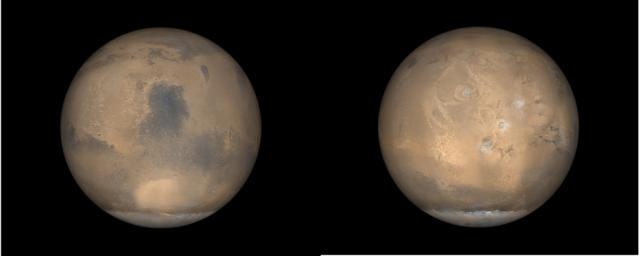Global Views of Mars in late Northern Summer
Caption:
Mars Global Surveyor (MGS) orbits around the red planet 12 times a day. Each orbit goes from pole to pole. Over the course of a single day, the wide angle cameras of the Mars Orbiter Camera (MOC) system take 24 pictures--12 red and 12 blue--that are assembled to create a daily global map. Such global views are used to monitor the martian weather and observe changes in the patterns of frost and dust distribution on the surface. These two pictures are examples of what Mars looks like in late northern summer, which is also late southern winter. At this time of year, the south polar cap (bottom, white feature in each image) is very large, extending from the south pole northward to 60°S. Also at this time of year, clouds of water ice crystals are common over the four largest volcanoes in Tharsis. The picture on the right shows Tharsis, with the four volcanoes forming a triangle resembling the pattern of holes on a bowling ball. The image on the left is centered on Syrtis Major, a dark, windswept volcanic plain so large that it has been known to science since the first telescopes were turned toward Mars in the 1600s. The elliptical bright feature at lower-center in the left image is the Hellas Basin, the largest unequivocal impact basin (formed by an asteroid or comet) on the planet. Hellas is approximately 2200 km (1,370 mi) across.
Cataloging Keywords:
| Name |
Value |
Additional Values |
| Target |
Mars |
|
| System |
|
|
| Target Type |
Planet |
|
| Mission |
Mars Global Surveyor (MGS) |
|
| Instrument Host |
Mars Global Surveyor |
|
| Host Type |
Orbiter |
|
| Instrument |
Mars Orbiter Camera (MOC) |
|
| Detector |
|
|
| Extra Keywords |
Asteroid, Color, Comet, Dust, Impact, Map, Volcano, Water |
| Acquisition Date |
|
| Release Date |
2002-04-23 |
| Date in Caption |
|
|
| Image Credit |
NASA/JPL/MSSS |
| Source |
photojournal.jpl.nasa.gov/catalog/PIA03755 |
| Identifier |
PIA03755 |

